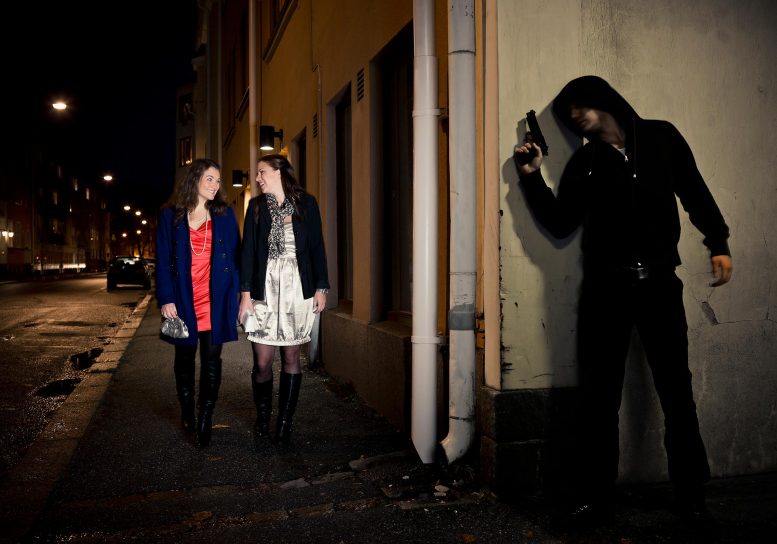
Researchers found that most types of crime, with the notable exception of homicide, significantly decreased during COVID-19 lockdowns.
A team of researchers led by the University of Cambridge and University of Utrecht examined trends in daily crime counts before and after COVID-19 restrictions were implemented in major metropolitan areas such as Barcelona, Chicago, Sao Paulo, Tel Aviv, Brisbane and London.
While both the stringency of lockdowns and the resulting crime reductions varied considerably from city to city, the researchers found that most types of crime — with the key exception of homicide — fell significantly in the study sites.
Across all 27 cities, daily assaults fell by an average of 35%, and robberies (theft using violence or intimidation, such as muggings) almost halved: falling an average of 46%. Other types of theft, from pick-pocketing to shop-lifting, fell an average of 47%.
“City living has been dramatically curtailed by COVID-19, and crime is a big part of city life,” said Prof Manuel Eisner, Director of the Violence Research Centre at the University of Cambridge and senior author of the study published in the journal Nature Human Behaviour.
“No drinkers spilling into the streets after nights out at bars and pubs. No days spent in shops and cafés or at the racetrack or football match. Some cities even introduced curfews. It choked the opportunism that fuels so much urban crime.”
“We found the largest reductions in crimes where motivated offenders and suitable victims converge in a public space. There would be far fewer potential targets in the usual crime hotspots such as streets with lots of nightclubs,” said Eisner.
Falls in crime resulting from COVID-19 stay-at-home orders tended to be sharp but short-lived, with a maximum drop occurring around two to five weeks after implementation, followed by a gradual return to previous levels.
Overall, the team found that stricter lockdowns led to greater declines in crime — although even cities with voluntary “recommendations” instead of restrictions, such as Malmo and Stockholm in Sweden, saw drops in daily rates of theft.
Theft of vehicles fell an average of 39% over the study sites. Researchers found that tougher restrictions on use of buses and trains during lockdowns was linked to greater falls in vehicle theft — suggesting that negotiating cities via public transport is often a prerequisite for stealing a set of wheels.
Burglary also fell an average of 28% across all cities. However, lockdowns affected burglary numbers in markedly different ways from city to city. While Lima in Peru saw rates plunge by 84%, San Francisco actually saw a 38% increase in break-ins as a result of COVID restrictions.
Data from many cities didn’t distinguish between commercial and residential. Where it did, burglaries of private premises — rather than shops or warehouses — were more likely to decline, with more people stuck indoors around the clock.
Reduction was lowest for crimes of homicide: down just 14% on average across all cities in the study. Dr. Amy Nivette from the University of Utrecht, the study’s first author, said: “In many societies, a significant proportion of murders are committed in the home. The restrictions on urban mobility may have little effect on domestic murders.
“In addition, organized crime — such as drug trafficking gangs — is responsible for a varying percentage of murders. The behavior of these gangs is likely to be less sensitive to the changes enforced by a lockdown,” said Nivette.
However, three cities where gang crime drives violence, all in South America, did see major falls in daily homicide as a result of COVID-19 policies. In Rio de Janeiro in Brazil, homicide dropped 24%. In Cali, Columbia, the drop was 29%, and in Lima, Peru, it plummeted 76%.
Rates of reported assaults also saw striking falls in Rio de Janeiro (56% drop) and Lima (75% drop). “It may be that criminal groups used the crisis to strengthen their power by imposing curfews and restricting movement in territories they control, resulting in a respite to the violence that plagues these cities,” said Eisner.
Researchers found Barcelona to be something of an “outlier”, with massive falls in assaults (84% drop) and robberies (80% drop). Police-recorded thefts in the Spanish city declined from an average of 385 per day to just 38 per day under lockdown.
London saw less pronounced but still significant falls in some crime, with daily robberies dropping by 60%, theft by 44% and burglaries by 29%. The two US cities in the study, Chicago and San Francisco, had their best results in the category of assault, falling by 34% and 36% respectively.
The research team found no overall relationship between measures such as school closures or economic support and crime rates during lockdowns.
Added Eisner: “The measures taken by governments across the world to control COVID-19 provided a series of natural experiments, with major changes in routines, daily encounters and use of public space over entire populations.
“The pandemic has been devastating, but there are also opportunities to better understand social processes, including those involved in causing city-wide crime levels.”
Reference: “A global analysis of the impact of COVID-19 stay-at-home restrictions on crime” by Amy E. Nivette, Renee Zahnow, Raul Aguilar, Andri Ahven, Shai Amram, Barak Ariel, María José Arosemena Burbano, Roberta Astolfi, Dirk Baier, Hyung-Min Bark, Joris E. H. Beijers, Marcelo Bergman, Gregory Breetzke, I. Alberto Concha-Eastman, Sophie Curtis-Ham, Ryan Davenport, Carlos Díaz, Diego Fleitas, Manne Gerell, Kwang-Ho Jang, Juha Kääriäinen, Tapio Lappi-Seppälä, Woon-Sik Lim, Rosa Loureiro Revilla, Lorraine Mazerolle, Gorazd Meško, Noemí Pereda, Maria F. T. Peres, Rubén Poblete-Cazenave, Simon Rose, Robert Svensson, Nico Trajtenberg, Tanja van der Lippe, Joran Veldkamp, Carlos J. Vilalta Perdomo and Manuel P. Eisner, 2 June 2021, Nature Human Behaviour.
DOI: 10.1038/s41562-021-01139-z









So, two unsuspecting white women walking down the street and you have what appears to be a black man with a gun about to attack them.
Stereotype much?
I actually found this image to be offensive and I’m a white male.
He doesn’t look very “black” to me.
Maybe I’m just colour blind.
I saw Barcelona, Sao Paulo and Tel Aviv in the intro and didn’t think it looked out of place.
In the small picture the shadow on the robber’s face makes him look black. Only when you enlarge it can you see he is white.